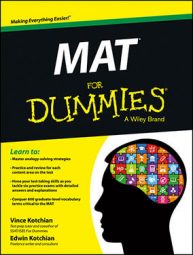The Miller Analogies Test writers are good at composing questions that are subtly designed to trick you. You can avoid common analogy traps on the MAT, however, if you have a plan of attack and a method for solving them.
In general, the later the question is in the MAT, the more likely it is to contain a trap, since the level of difficulty increases as you go. On the other hand, the earlier in the test a question appears, the less likely it is to contain a trap. Questions later in the test are ones that most previous test takers answered incorrectly.
You encounter three main types of analogy traps on the MAT: category traps, direction traps, and distractor traps.
Forewarned is forearmed: Now that you know traps await you on the MAT, you’ll be less likely to fall for them.
Category analogy traps on the MAT
Category traps are questions written to try to trick you into misidentifying the analogy’s structure category — for example, making you think it’s a 1:2,3:4 when it’s really a 1:3,2:4, or vice versa. To do this, the test writers often pick terms designed to lead you astray from the question’s correct relationship. Check out the following difficult question:
Saturnine: planetary :: gloomy : _________________
(A) morose
(B) ebullient
(C) obscured
(D) immense
Quick, is this a 1:2,3:4 or a 1:3,2:4? If you said 1:2,3:4, you fell for the trap. Although saturnine and planetary may have made you think of Saturn and the planets, these terms aren’t related. Saturnine means “gloomy,” and one meaning of planetary is immense (huge).
This question is made more tricky by the inclusion of morose (which means “gloomy”) as one of the answer choices, making it even more tempting to categorize the question as 1:2,3:4, compose a sentence like “Saturnine means planetary, and gloomy means morose,” and then pick Choice (A).
However, this analogy actually has a 1:3,2:4 structure: The correct answer is Choice (D). Something saturnine is also gloomy, as something planetary is also immense. Of course, this question is tougher if you don’t know the meanings of all the terms.
But even if you do know all the terms, be careful. It can be all too easy to miscategorize an analogy’s structure if the test writer is trying to mislead you.
Be careful also of going too quickly and not taking the time to think of the dictionary definitions of terms. Category traps often prey on people who can’t or don’t define terms accurately.
Be especially careful of category traps in the last third (questions 81–120) of the MAT. Since the MAT’s difficulty level increases as you go, terms that at first seem to be related often are not.
Direction analogy traps on the MAT
Whether it’s a 1:2,3:4 or a 1:3,2:4, an analogy sometimes has a built-in directional trap. Direction traps try to trick you by providing the relationship you want but giving it to you in the wrong direction. Consider the following question:
Candy : gummy bear :: _________________ : fruit
(A) food
(B) banana
(C) caramel
(D) seed
It’s fairly easy to determine this analogy’s structure: It’s a 1:2,3:4. But if you picked Choice (B), banana, you fell for the trap. This is called a direction trap because picking Choice (B) reverses the analogy relationship’s direction.
A gummy bear is a type of candy, but fruit is not a type of banana — a banana is a type of fruit. In other words, if the second term is a type of the first term, the fourth term has to be a type of the third term.
The right answer is Choice (A), food, because a gummy bear is a type of candy, as fruit is a type of food.
Direction traps are much easier to fall for if you’re rushing. When you write down your sentence for the analogy’s relationship, take the time to make sure it works in the same direction for both term pairs.
Direction traps aren’t particularly hard to avoid if you know they’re coming. Since they’re not as tricky as category traps, they can and will show up throughout the MAT.
Distractor analogy traps on the MAT
Distractor traps work by supplying you with an answer choice that, at first glance, may seem to have a lot in common with the term you’re pairing it with — but upon closer inspection, it doesn’t. Here’s an example of a tougher question with a distractor trap:
METICULOUS : EXACTING :: CURRENCY _________________
(A)denomination
(B)quarter
(C)mint
(D)acceptance
The analogy is a 1:2,3:4, since meticulous means “exacting.” Notice that Choices (A), (B), and (C) may be distracting because they all have some relation to the more commonly used definition of currency (money). However, if you take the time to make a sentence, you won’t get fooled. Meticulous means “exacting,” as currency can mean “acceptance.”
Distractor traps are more likely to appear in the latter third (questions 81–120) of the MAT, since, by then, the difficulty level is high.
The bottom line is, if you want to accurately determine an analogy’s structure while avoiding any traps, you’ve got to recognize the relationship being presented to you. Make sure you take the time to consider all the answer choices before deciding whether it’s 1:2,3:4 or 1:3,2:4; if you don’t categorize it correctly, you’re much more likely to get the question wrong.

